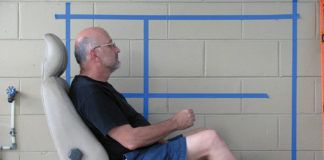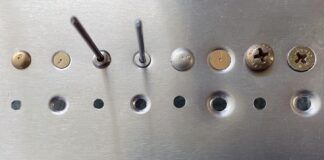We have finally reached the end of the diagnostic phase in our quest to improve the longitudinal flying qualities of an airplane. At this point we know whether the pitch-sensitivity problem is caused by a lack of basic airplane stability (too little static margin) or by control-surface hinge-moment effects or other characteristics of the control system. We can now proceed to design modifications to improve the airplanes flying qualities. The proper course of action depends on which specific deficiency is the root cause of our handling problem.
Lack of Static Margin
If the airplane has too little static margin, the center of gravity (CG) is not far enough ahead of the aerodynamic center. The airplane is pitch-sensitive because it requires little change in elevator position to produce a large change in trimmed angle of attack. If an airplane has enough pitch damping, it may be possible for a good pilot to fly it with neutral to slightly unstable static margin, but the pilot workload will be high and is unacceptable for normal operations.
To increase static margin, we must increase the distance between the CG and the aerodynamic center so that the CG ends up further forward of the aerodynamic center. To accomplish this, we can move the CG forward or the aerodynamic center aft. A combination of the two can also be successful.
Almost all of the available fixes will exact some performance penalty. For the best solutions, the performance penalty can be small enough to be negligible. Do not let the prospect of a small performance reduction keep you from fixing the handling problem. Failing to remedy dangerous handling qualities to keep from losing a few knots of cruise performance is a poor and foolish trade.
Shifting CG by Moving
Things Forward
To move the CG of the airplane forward we must shift a significant weight a significant distance forward. The distance an object must move to cause a given CG change varies linearly with the weight of the object. The heavier the item, the less distance it must move. It is difficult to get the necessary CG shift by moving internal components around, because remarkably few of them can be moved easily, and those that can be easily relocated are rarely heavy enough to make the necessary difference. This problem is exacerbated because conventional tractor airplanes have long tail cones and short noses. The short nose leaves little room to move items forward. Unfortunately, the long tail cone makes it possible to shift the CG aft excessively by placing relatively light objects (like autopilot servos) far aft. If these are the cause of the aft-CG problem, then moving them can help significantly.
The one moveable component that is heavy enough to make a difference is the battery. If the battery is mounted aft of the cockpit, and the CG of the airplane is too far aft, then moving the battery forward can have a significant beneficial effect. Designers often use the battery as “CG insurance.” Some designers deliberately design with an aft-mounted battery so that they have something heavy they can easily move to the firewall if the airplane turns out to be tail-heavy.
It is usually advisable to move only components that are part of the empty airplane to correct an aft-CG problem. Anything that varies in weight from flight to flight (like people and baggage) or changes weight in flight (fuel) presents a problem because of its variability. Moving the empty CG of the airplane forward moves the CG farther forward at all loading conditions. Moving a variable-weight item may help at some loading conditions and not at others.
There is one situation in which moving fuel forward can help. If the airplane has an aft-mounted fuel tank (usually a fuselage tank behind the cockpit), then it may be tail-heavy when this tank is full but have acceptable static margin when the fuel from the aft tank is burned off. Moving fuel carriage from the aft tank to a more-forward tank near the empty-airplane CG will cut the CG travel due to fuel burn, and will cause the CG to be more forward at full fuel.
This approach only works if the airplane has acceptable static margin with minimum fuel aboard. If the airplane is tail-heavy with empty tanks, moving fuel forward to move the CG forward does not work well. If the fuel tank is forward of the empty CG, the airplane will have a forward CG with full tanks, but the CG will move aft as the fuel is burned. The airplanes longitudinal flying qualities will deteriorate as the fuel burns off, leaving the pilot with a difficult-to-fly airplane near the end of the flight. To remain safe, the pilot will have to treat some of the fuel as though it were ballast rather than consumable. This aft-creeping CG condition is particularly noticeable on airplanes with fuel tanks mounted between the firewall and the instrument panel.
A far-aft baggage compartment can also be a source of CG problems. If the airplane behaves well with no baggage, but has too little static margin with baggage aboard, the designer has two choices. The first is to find a more-forward place to carry baggage. The second is to find a way to move the empty CG far enough forward that loading the baggage compartment does not move the CG behind the aft limit.
The big gun when it comes to moving airplane components around to adjust CG is the engine. It is usually the heaviest fixed component that can be moved relative to the flying surfaces. Moving the engine is not trivial and can have a dramatic effect on the CG position.
Engine position is another way a designer can hedge his bet on CG position. One approach that has been used, particularly on prototypes, is to delay designing the engine mount and cowl until the rest of the airplane is essentially complete. The completed but engineless airframe is then weighed. Using this information, the designer can calculate the engine position needed to give the desired CG and design the engine mount and cowling accordingly.
It is not quite so easy on an existing airplane. To fix a tail-heavy condition, the engine must move forward. This will require replacement of the engine mount, and at the very least a major reworking of the cowling. Fuel lines, throttle and other engine-control cables will likely have to be replaced or modified. Moving the engine forward will increase the droop loads being transmitted to the firewall by the engine mount and the loads on the mount itself. The new stresses on the engine mount, firewall, and engine-mount attach points must be determined. Modifications to strengthen the firewall and mount-attach points may be necessary, and will also increase empty weight. Moving the engine forward is an effective way of moving the CG, but it is a classic illustration of the old saying, “There is no such thing as a minor modification to an airplane.”
Using Ballast
Another way to adjust the CG position of the airplane is to add ballast. In the case of a tail-heavy airplane, the ballast must be located as far forward as possible. Adding ballast is usually simpler than moving around components of the airplane, because it does not require changes to systems or controls. Simplicity is the only real advantage to using ballast. It is often easier to ballast the airplane than to do other more extensive modifications to correct the problem. However, ballast adds weight to the airplane without providing any benefit other than CG adjustment. It is frustrating to put a lot of effort into designing a lightweight, efficient airplane structure only to be forced to make it carry around useless weight to make it balance. Also, the weight of the ballast must be subtracted pound for pound from the useful load of the airplane. Range and/or payload will suffer.
The ballast must also be mounted securely enough to stay put under all flight conditions in the envelope. More than one accident has been caused by ballast shifting or breaking loose.
Moving the Aerodynamic Center
A second way to increase the static margin of an airplane is to move the aerodynamic center aft, and there are several ways to accomplish this. One method is to move the wing aft. This is very effective aerodynamically, as the wing produces most of the lift of the airplane. The aerodynamic center will move almost as quickly as the wing, so a relatively small movement of the wing will have a large effect. A second advantage of this approach is that it does not increase the wetted area of the airplane or its weight. During preliminary design, it is quite common to move the wing back and forth as the design evolves to ensure proper balance.
Unfortunately, while it is easy to move the wing when the airplane exists only on paper or in the computer, it is quite another thing to move the wing on an existing airplane. At best it is a major modification, requiring significant disassembly of the airplane, and extensive modifications to structure and systems.
On a biplane (or a parasol monoplane), moving the upper wing fore and aft is easier because the upper wing is strut-mounted and does not have a carry-through structure built into the fuselage. Adjusting or replacing the cabane and interplane struts and re-rigging the bracing wires allow the wing to be moved fore and aft relatively simply. I have been told that one reason the Stearman was used so extensively as a crop duster was that it was easy to rig the upper wing forward or aft to adjust for the CG changes caused by the addition of the spray hopper and a different engine.
Tail Modifications
Modifying the horizontal tail surfaces is another way to increase static margin. The goal is to increase the stabilizing influence of the horizontal tail. To do this we must increase the amount of pitching moment the tail generates in response to a change in airplane angle of attack.
The most obvious approach is to simply add area to the horizontal stabilizer. A bigger tail will produce more lift at a given angle of attack, and thus more pitching moment. The disadvantage is that it increases weight and wetted area, causing a small increase in drag and reduction in useful load. Unless the airplane is terribly unstable, the performance penalty of an enlarged horizontal tail is small.
An interesting variation on the “bigger tail” approach is to add an additional horizontal surface, separated vertically from the original tail. An example is the Beech 1900, which uses the T-tail assembly from an earlier King Air variant. In flight test, it was discovered that the 1900 did not have acceptable static margin when loaded to its most-aft CG. Designing and tooling a new, larger tail, or re-stressing the existing tail to allow it to carry extensions both appeared to be too expensive. Instead, the Beech designers added a pair of fixed horizontal surfaces, mounted on the aft fuselage. These supplemental tails moved the aerodynamic center aft enough to render the airplane acceptable at lower cost than re-engineering the basic T-tail.
Another way to increase the effectiveness of the horizontal tail is to increase the tail arm by lengthening the fuselage to move the tail aft. This is a relatively common approach during the initial design phase, but it is usually unacceptably difficult to modify an existing airplane this way. Such modifications have been made on composite prototypes where the tail was sawn off, the fuselage extended, and the tail reattached. But for the average homebuilder, trying such a thing could rapidly become a nightmare. Lengthening the fuselage is a major undertaking, involving structural, aerodynamic and systems changes. The longer fuselage will be heavier, and have more wetted area than the original.
The rate of change of lift coefficient of a surface with changing angle of attack is a function of the aspect ratio. Increasing aspect ratio makes the lift vary more rapidly. Accordingly, a high-aspect-ratio surface will experience a greater lift change for a given angle of attack change than a low-aspect-ratio surface. For a horizontal tail surface, this means the tail will be more stabilizing if its aspect ratio is increased. Increasing the aspect ratio of the tail while holding the area constant will move the aerodynamic center aft and increase the static margin. The advantage is that it does not increase parasite drag and may cause a small reduction in trim drag. The higher-aspect-ratio tailplane will be slightly heavier than the low-aspect-ratio surface it replaces, but the difference will be small.
While replacement of the entire tailplane with a new, higher-aspect-ratio surface on an existing airplane may prove unattractive, the fact that increasing aspect ratio increases tail effectiveness is still important. If we decide to modify the existing tailplane, it will be much more effective to add span extensions (which increase both area and aspect ratio) than to add chord (which will increase area but reduce aspect ratio). Because of this, satisfactory static margin can be achieved with a smaller increase in tail area.
Next month we will conclude our longitudinal flying qualities marathon with a discussion of ways to fix problems arising from elevator hinge-moment and control-system characteristics.













